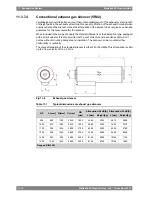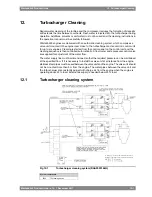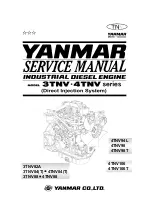
balancing, frequency adjustment, or generator loading/unloading control in the external control
system.
In a speed droop system each individual speed control unit decreases its internal speed
reference when it senses increased load on the generator. Decreased network frequency with
higher system load causes all generators to take on a proportional share of the increased total
load. Engines with the same speed droop and speed reference will share load equally. Loading
and unloading of a generator is accomplished by adjusting the speed reference of the individual
speed control unit. The speed droop is normally 4%, which means that the difference in
frequency between zero load and maximum load is 4%.
In isochronous mode the speed reference remains constant regardless of load level. Both
isochronous load sharing and traditional speed droop are standard features in the speed
control and either mode can be easily selected. If the ship has several switchboard sections
with tie breakers between the different sections, then the status of each tie breaker is required
for control of the load sharing in isochronous mode.
14.3
Alarm and monitoring signals
Regarding sensors on the engine, please see the internal P&I diagrams in this product guide.
The actual configuration of signals and the alarm levels are found in the project specific
documentation supplied for all contracted projects.
14.4
Electrical consumers
14.4.1
Motor starters and operation of electrically driven pumps
Separators, preheaters, compressors and fuel feed units are normally supplied as
pre-assembled units with the necessary motor starters included. The engine turning device
and various electrically driven pumps require separate motor starters. Motor starters for
electrically driven pumps are to be dimensioned according to the selected pump and electric
motor.
Motor starters are not part of the control system supplied with the engine, but available as
optional delivery items.
14.4.1.1
Engine turning device (9N15)
The crankshaft can be slowly rotated with the turning device for maintenance purposes. The
motor starter must be designed for reversible control of the motor. The electric motor ratings
are listed in the table below.
Table 14-2
Electric motor ratings for engine turning device
Current [A]
Power [kW]
Frequency [Hz]
Voltage [V]
Engine
5
2.2/2.6
50/60
3 x 400/440
6L, 7L, 8L
12
5.5/6.4
50/60
3 x 400/440
9L, V-engines
14.4.1.2
Pre-lubricating oil pump
The pre-lubricating oil pump must always be running when the engine is stopped. The pump
shall start when the engine stops, and stop when the engine starts. The engine control system
handles start/stop of the pump automatically via a motor starter.
It is recommended to arrange a back-up power supply from an emergency power source.
Diesel generators serving as the main source of electrical power must be able to resume their
14-8
Wärtsilä 46F Product Guide - a19 - 1 December 2017
Wärtsilä 46F Product Guide
14. Automation System
Summary of Contents for 12V46F
Page 1: ...PRODUCT GUIDE Wärtsilä 46F ...
Page 44: ...This page intentionally left blank ...
Page 52: ...This page intentionally left blank ...
Page 78: ...This page intentionally left blank ...
Page 102: ...This page intentionally left blank ...
Page 124: ...This page intentionally left blank ...
Page 144: ...This page intentionally left blank ...
Page 162: ...This page intentionally left blank ...
Page 186: ...This page intentionally left blank ...
Page 192: ...This page intentionally left blank ...
Page 194: ...This page intentionally left blank ...
Page 197: ......
Page 198: ......
Page 199: ......
















































